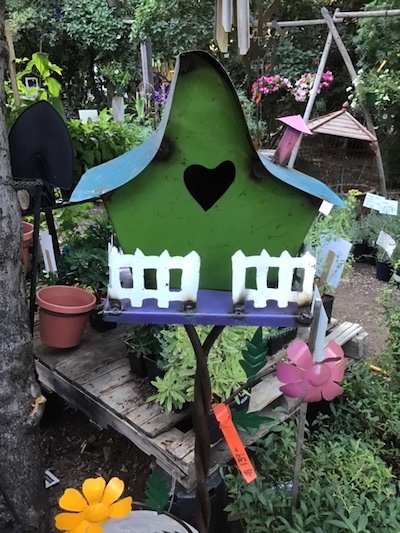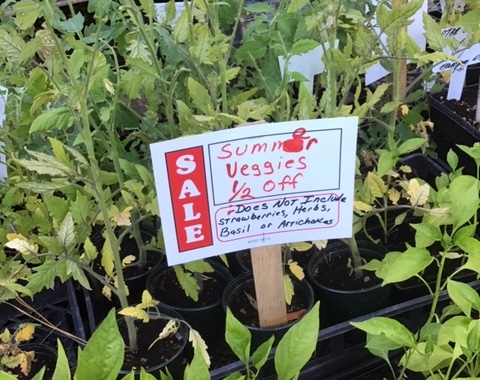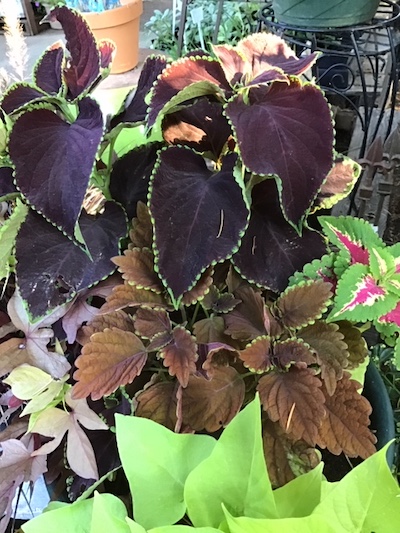July 2020 News
Closed July 4th

Here we are halfway through 2020 and into July, the month where the evapo-transpiration is the highest of the year. That means not only is water evaporating from the ground, but the plants are also transpiring through their leaves. I would say number one this month is to keep up on your water schedule, and possibly you will need to increase it for the next 6 weeks or so. Your plants should let you know if they are getting enough or not.
Last month was Pollinator month/week, and we sort of missed the boat on doing any pollinator promo. A lot of you have already planted flowers to attract butterflies and hummingbirds. But what about the other beneficials. You know the unglamorous ones like parasitic wasps, big-eyed bugs, and hoverflies? The ones that keep the bad bugs in check. Maybe you have the more well-known ladybugs and praying mantids, so that is a start. Let’s talk about attracting some of the lesser-known ones and what plants attract them.

Lacewings in their larval stage eat aphids, mites, and other insect eggs.
Good plants to attract: Fern leaf Yarrow, Dill, Cosmos, and Queen Anne’s Lace.
Ladybugs and their larvae- aphids, whitefly, mites. Plant Yarrow, Ajuga, Dill, Butterfly Weed (Asclepias), Fennel, Queen Anne’s Lace.
Hoverflies, aka Syrphid Fly- aphids and mealybug. Plant Yarrow, Ajuga, Feverfew, Coriander, Queen Anne’s Lace, Fennel, Lavender, Lemon Balm, Spearmint, Parsley, Rudbeckias, Sedums, and Goldenrod.
Braconid, Ichneumonid, and Trichogramma parasitic wasps- Their larvae can kill caterpillars, including tomato hornworms by the Braconid Wasp. Plant Yarrow, Dill, Coriander, Cosmos, Queen Anne’s Lace, Fennel, Alyssum, Lemon Balm, Parsley, Tansy.
Tachinid Flies- cabbageworm, squash bug nymphs. Plant Anthemis, Lemon Balm, Pennyroyal, Parsley, Tansy, and Thyme.
Minute Pirate Bugs-thrips, aphids, whitefly, Damsel Bugs, and Big Eyed Bugs- leaf-hoppers and spider mites. Plant Caraway, Cosmos, Fennel, Goldenrod, Lemon Gem Marigolds.
As you can see, several plants attract a lot of the beneficials. Duplicating many times were Yarrows, Fennel, Lemon Balm, Queen Anne’s Lace, and Cosmos. They really like things where the flower is actually a cluster of smaller blooms. For best results, plant a wide variety with different bloom time in 4-foot square sections. Don’t use pesticides as the bad bugs recover faster than the good ones. A water feature or birdbath will also help attract your good guys. For pictures of what these bugs look like and more info, do your own web search of beneficial insects.

Hopefully, by now you are reaping the benefits of your hard work, with vegetables growing and flowers blooming. Do summer pruning on your fruit trees to keep them manageable, and remember it is recommended to prune apricots and cherries after the fruit is finished to prevent disease. Just be careful not to open the centers of your trees up to the harsh sun. Continue feeding your roses after each bloom cycle and feed your vegetable garden often…once a month with a granular food or every week or two if using a liquid. End rot on your Roma tomatoes? Or your Zucchini starts but then turns brown from the blossom end. This is Blossom End Rot. Fruit not setting? Calcium sprays can help with both of these issues.
Most of our bark is back in stock, along with steer manure. We have some more tomato cages and just got in more of our larger wood stakes. The Rustic Arrow order arrived with funky metal birdhouses, animals, and stakes, including some cool moons. A local woman is making earwig traps, and we have some in stock. Cheaper than Sluggo Plus for the long haul, and they come with directions. Orders are taking extra long to get here. Our next pottery order is scheduled to arrive on July 7th, and we are getting low on inventory in that department.
The Echinaceas and Rudbeckias are starting to bloom and will keep blooming into fall. The Crape Myrtles are in bloom along with the Oleanders, and the Rose of Sharons are just starting. Those tougher hydrangeas like the Oak Leaf and the Pee Gees are looking good. We have someone gallon Meyer Lemon in stock now, which we are not always able to find. We are selling all summer vegetable starts and bulbs on hand at half off. We actually have quite a few.
July Specials

- Half Off-Remaining Summer bulbs, Vegetable starts, and Pages Seed.
- 20% off Buddlejas/Butterfly Bushes
fast-growing and long-blooming - 20% off 5 gal Yuccas in stock
low water use, deer resistant and low maintenance
good in containers - Introductory Offer :
EB Stone’s New 420 Fertilizers arriving next week
Chock full of great stuff for your soil
Plant of the Month
Solenostemon scutellarioides
AKA Coleus

We can’t say enough about this plant. It is so hard to find a plant that will give you good color in a shady spot, but these can. Some varieties will also grow in sun if watered enough, but I would avoid all day sun. The Kong series sports huge leaves while Cleosaurus can grow to 2 ft tall. Some varieties are solid chartreuse green or a rusty red or solid wine color, while others are flecked, edged, or multi-colored. Colors range from lime green, burgundy, reds, pinks, salmons to almost brown, with the reds being the most sun tolerant. Plant up a container with several different kinds with some lime green potato vine, gold creeping jenny, or other complementary trailing plants. These plants will freeze here, but you can grow cuttings in water over winter. Coleus makes good houseplants in strong indirect light. For best results, pinch them back for better branching, remove the blue flowers, and feed with a high nitrogen fertilizer.